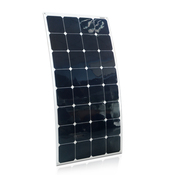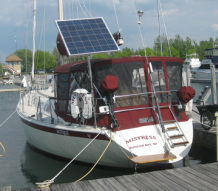|
We tested our new 150 watt polycrystalline solar panel on a 35 day cruise in the North Channel area of Northern Lake Huron. This panel was equipped with the prototype of our solar water heating system which will be addressed in another blog entry. The solar panel was mounted on our pole mounting system and was rotated toward the sun The boat equipment and cruising pattern was essentially the same as last year (See prior blog entries). We were powering a freezer/refrigeration system, instruments, laptop computer, radios, autopilot, windlass and LED lights. Data was gathered using the remote display on our EP 10 amp dual output solar controller. The solar panel performance met our expectations. Our house battery bank consists of three 120 amp hour flooded batteries.
Both battery banks were usually fully charged by 2 PM when at anchor and on mostly sunny days so we often had excess power. Data comparing the performance of the 150 watt solar panel with our 140 and 160 watt panels is presented below. Average amp hours per day produced under various conditions: 150 Watt poly 140 Watt, poly 160 Watt, mono 160 Watt, mono 2015 2012 2013 2014 Overall average output per day 49 amp hours 53 amp hours 48 amp hours 48 amp hours Sunny days 60 69 71 69 Mostly sunny days 56 50 50 56 Mostly cloudy days 36 35 37 39 Cloudy days 22 32 28 20 Avg. Output on days at anchor 60 62 61 51 Avg. Output when engine was used 42 43 44 45 Min amp hrs for a day 4 27 28 4 Max amp hrs for a day 84 74 77 76 Max amps output 11.8 amps 10.5 amps 11.5 amps 11.4 amps This data is intended to provide a general idea of what to expect from the solar panels under various conditions. The two primary variables are the amount of sunshine and the running of the engine (the alternator charges the batteries so the controller shuts off power from the panels). Because the panel was equipped with a water heat collector on the back, it may have run hotter on sunny days when the water circulation pump wasn't run thus degrading the performance by up to 10%.The average panel output on sunny days at anchor with no motoring was 67 amp hours.
1 Comment
 100 Watt Flexible Solar Panel 100 Watt Flexible Solar Panel When our supplier told me they had a new high output marine solar panel that was flexible I was skeptical. The specifications seemed just to good to be true. So I ordered some to test. Well, I was pleasantly surprised. These panels are very well constructed and they have a power generation comparable to our hard panels. These panels can be flexed to 30 degrees so can conform to most boat curved surfaces. The 100+ watt panels have an electrical box on the front (not shown in the picture) which contains two blocking diodes. The 50 watt panel has one blocking diode. The base material is very sturdy and strong. Each panel has grommets for attaching the panel. I have tested the output of these panels under various weather conditions and their susceptibility to shading. Below is a quick comparison of output of our three mid-range panels laying flat at mid day on a mostly sunny day measured with a meter: Flexible 100 watt Rigid 105 watt Rigid 100 watt Monocrystalline Monocrystalline Polycrystalline Short Circuit Current (Isc) 5.48 amps 5.50 amps 5.26 amps Open Circuit Voltage (Voc) 19.2 volts 19.7 volts 20.5 volts Computed Power (not rated power) 105 watts 108 watts 108 watts Additional information is available on our solar panel page.  140 Watt Poly-crystalline Solar Panel 140 Watt Poly-crystalline Solar Panel In an earlier blog entry dated 8/10/2011 I documented the performance of our 130 watt mono-crystalline solar panel on a 22 day cruise in the upper Great Lakes. In an August 2012 blog entry I documented the performance of our 140 watt poly-crystalline solar panel. This year I documented the performance of our 160 watt mono-crystalline solar panel on the same boat under similar conditions. The only variables were the weather and the running of the engine when moving from anchorage to anchorage (wind was on our nose quite often this summer). The number of days of each cruise varied so I an presenting average performance based on four weather conditions; sunny, mostly sunny, mostly cloudy and cloudy. Test conditions:
Test Results: Definition: amp hour – amps produced or consumed in one hour Average amp hours per day produced under various conditions: 130 Watt, mono 140 Watt, poly 160 Watt, mono Overall average output per day 54 amp hours 53 amp hours 48 amp hours Note: 160W had only 5 sunny days, 140W had 10 sunny days and 130W had 8 sunny days Sunny days 71 69 71 Mostly sunny days 51 50 50 Mostly cloudy days 46 35 37 Cloudy days 24 32 28 Avg. Output on days at anchor 62 62 61 Avg. Output when engine was used 35 43 44 (difference partially because 130W was often disconnected often when engine was used. Not so for 140W and 160W) Min amp hrs for a day 16 27 28 Max amps output 10.5 amps 10.5 amps 11.5 amps Interpreting the Results: Each solar panel performed about as expected. The average daily output was less for the 160 watt panel but it had half as many sunny days and comparable mostly sunny days. The 130 watt mono panel provided a slightly higher average output on sunny days and the 140 watt poly panel provided a higher average output on cloudy days. The max output of the 160 watt panel was an amp higher that the others. My sense was that the poly-crystalline panel was less sensitive to shading from the rigging but this is difficult to document. On sunny days, both solar panels often performed above their sticker rating of 130, 140 and 160 watts by as much as 50 watts (9.5 amps at 21 volts is 189 watts) . I believe this is due to the high quality of silicone crystals used. Observations: All three solar panels generally met our power needs for the duration of the cruises. We occasionally ran a small deficit of amp hours during an extended anchorage when cloudy but never needed to use the engine alternator to charge the battery banks except when motoring from place to place. On days when the engine was used we often had an excess of power generation from the 75 amp alternator and the solar panel. Choosing the right type of solar panel: Based on the performance data, each solar panel will perform adequately under most conditions. The 130 watt and 160 watt mono-crystalline solar panels are an excellent choice for boats in mostly sunny areas with little possibility of shading from the rigging. The 140 watt poly-crystalline solar panel is an excellent choice for areas with more partly cloudy and cloudy days and on boats where there is some shading from the rigging. The following is the result of testing the CMP130 watt monocrystalline solar panel with the top-of-pole mount and dual output controller cruising for 3 weeks in the North Channel of northern Lake Huron. The panel mounting system is shown on our Gallery of Installations; the Ericson 38. (Well, somebody has to do it. :-) )
Test conditions:
Date Amp Conditions of the day Hours 7-7 46 At dock, shore power on 7-8 39 Motored 4 hours, partly cloudy 7-9 17 Motored all day, cloudy tried solenoid 7-10 26 Cloudy, motored 1 hour, sun 5-6 hours 7-11 55 Mostly sunny, travel day – under sail 7-12 64 Mostly sunny, at anchor 7-13 79 Mostly sunny, at anchor, reset meter when rewired batteries 7-14 70 Mostly sunny, at anchor, panel not turned for part of the day 7-15 49 Cloudy morning, sunny afternoon, motored for 2 hours with solenoid on 7-16 51 Mostly sunny, motored 2 hours with solenoid on, topped off batteries 7-17 34 Mostly cloudy, at anchor all day 7-18 47 Mostly cloudy, motored 2 hours 7-19 20 Hazy, cloudy, motored 2 hours 7-20 71 Sunny, at anchor 7-21 80 Sunny, at anchor 7-22 67 Mostly sunny, ran engine 1.5 hrs, topped off batteries 7-23 39 Mostly cloudy, at anchor 7-24 73 Mostly sunny, at anchor 7-25 68 Mostly sunny, at anchor 7-26 16 Hazy, cloudy, motored 4 hours, topped off batteries 7-27 26 Cloudy, hazy, motored 9 hours, batteries charged 7-28 42 Mostly sunny, motored 2 hours with panel connected, batteries charged Analysis: Definition: amp hour – amps produced or consumed in one hour Average amp hours per day produced under various conditions: Overall (22 days) 54 amp hours Sunny days at anchor 71 Cloudy days at anchor 37 All days at anchor 62 Days engine was used 35 Max amp hrs for a day 80 Min amp hrs for a day 16 Max amps output 10.5 amps Conclusion: The 130 watt panel generally met our power needs for the duration of the cruise. We occasionally ran a small deficit of amp hours during an extended anchorage but never used the engine alternator to charge the battery banks except when motoring from place to place. On days when the engine was used we often had an excess of power generation from the 75 amp alternator and the 130 watt solar panel. The solar panel is very sensitive to cloudy days and to shadows. The panel output on sunny days exceeded it rating. This is the nature of mono-crystalline solar panels. |
Categories
All
AuthorThomas Trimmer has been cruising with his Ericson 38 sailboat on the Great Lakes for over 20 years. He has pioneered the use of solar energy for wilderness cruising. He is continually designing and building equipment to simplify and enhance the cruising experience. Archives
April 2024
|
Efficiently Powering Your Vessel/Van. Call/email/chat any time, we're happy to help you work through designing your solar system.
Home Page Solar Panels Mounting Kits Product Page Marine Solar Systems Gallery of Installations Customer Comments Contact Us
Call 248 705-8337 or email [email protected]
Article On How To Size Your Solar Panels For Your Boat
Customer Reviews Return Policy Privacy Policy Shipping Times/Rates
Home Page Solar Panels Mounting Kits Product Page Marine Solar Systems Gallery of Installations Customer Comments Contact Us
Call 248 705-8337 or email [email protected]
Article On How To Size Your Solar Panels For Your Boat
Customer Reviews Return Policy Privacy Policy Shipping Times/Rates

 RSS Feed
RSS Feed